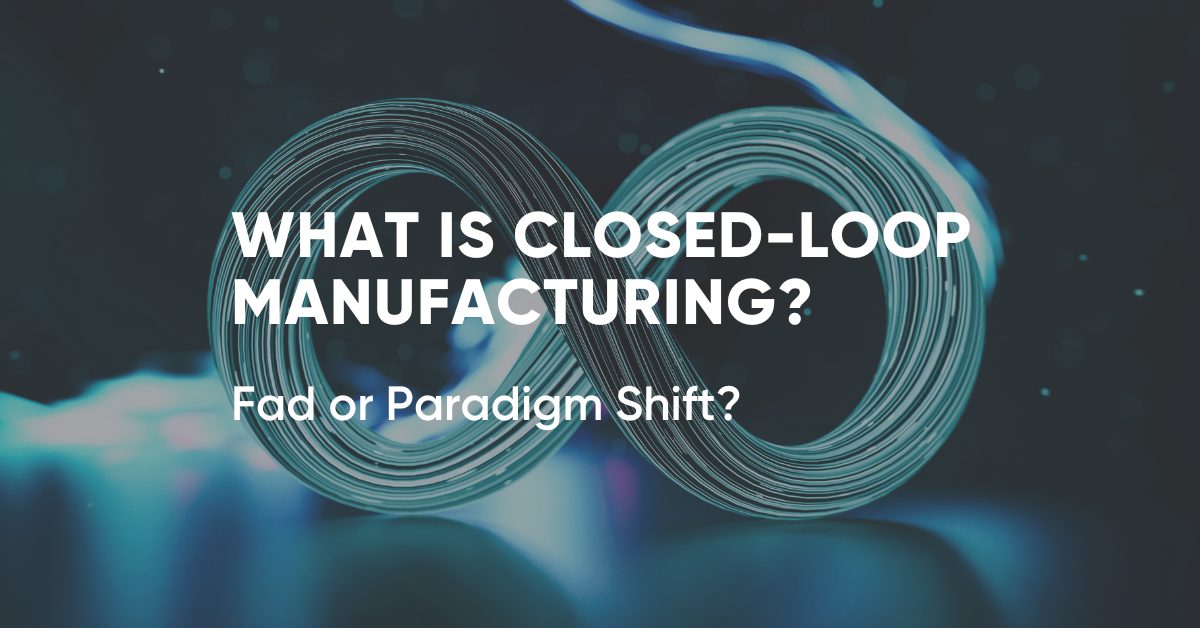The manufacturing industry is evolving at a never seen before pace. Staying ahead of the curve is not just a strategic choice but a necessity. One concept that has emerged as a game-changer is “Closed-Loop Manufacturing.”
This sophisticated approach is not merely a buzzword; it’s a transformative strategy that integrates data, technology, and sustainability principles to reshape the manufacturing landscape. For manufacturing leaders, particularly those steering operations, finance, and strategy, a comprehensive understanding of Closed-Loop Manufacturing is not just valuable—it’s imperative. Let’s dissect the intricacies of Closed-Loop Manufacturing, its key components, and showcase real-world examples of businesses that have not only invested in but thrived through the adoption of this groundbreaking paradigm.
Defining Closed-Loop Manufacturing
At its core, Closed-Loop Manufacturing represents a departure from traditional linear production models. It encompasses a holistic strategy that intertwines data, technology, and sustainability throughout the entire manufacturing process. Unlike the linear approach, which follows a ‘take-make-dispose’ trajectory, closed-loop systems aim for circularity, fostering a sustainable and efficient flow of resources. The approach hinges on continuous monitoring, analysis, and optimization of processes, creating an environment where real-time data becomes the guiding force for decision-making.
Key Components of Closed-Loop Manufacturing
Data Integration and Connectivity: Closed-loop systems thrive on data. From shop floor sensors to enterprise resource planning (ERP) systems, every piece of information is seamlessly integrated. This interconnectedness allows for a holistic view of the manufacturing process.
Real-Time Monitoring and Analytics: The heart of closed-loop manufacturing lies in its ability to monitor operations in real-time. Sensors and IoT devices collect data, feeding it to analytical tools at the edge to provide insights into production efficiency, quality control, and resource utilization.
Feedback Mechanisms: Closed-loop systems are not just data collectors; they are learning systems. Feedback loops enable the system to adapt and optimize based on the insights gained from data analysis. This iterative process is fundamental to the continuous improvement aspect of closed-loop manufacturing.
Sustainability and Resource Management: One of the central tenets of closed-loop manufacturing is minimizing waste and maximizing resource efficiency. This includes recycling and reusing materials wherever possible, reducing environmental impact, and aligning with sustainable manufacturing practices.
Real-World Examples of Closed-Loop Manufacturing Success Stories
Tesla’s Gigafactory:
Tesla, known for its innovation in electric vehicles, has implemented closed-loop manufacturing principles in its Gigafactory. By reusing and recycling materials like lithium and cobalt from old batteries, Tesla has not only reduced waste but also decreased its reliance on scarce resources, contributing to a more sustainable production process.
Siemens:
Siemens, a global powerhouse in electronics and electrical engineering, has embraced closed-loop manufacturing in its Amberg Electronics Plant. Through real-time monitoring and data analytics, Siemens has optimized production processes, leading to a 99.99885% quality rate and a substantial reduction in energy consumption.
Caterpillar:
Caterpillar, a leader in construction and mining equipment, has implemented closed-loop manufacturing in its Remanufacturing Division. By remanufacturing components and recycling materials, Caterpillar has not only reduced waste but has also realized significant cost savings, contributing to a more economically sustainable business model.
Measurable Results: Closing the Loop on Success
The implementation of closed-loop manufacturing strategies has yielded tangible results for businesses across industries. These measurable outcomes include:
Cost Reductions: Closed-loop manufacturing minimizes waste, optimizes resource utilization, and enhances overall efficiency. Businesses report significant cost reductions in production and material expenses.
Improved Quality: Real-time monitoring and analytics contribute to a higher level of quality control. This not only reduces defects but also enhances customer satisfaction, ultimately contributing to increased market competitiveness.
Enhanced Sustainability: By prioritizing resource efficiency and minimizing environmental impact, closed-loop manufacturing aligns with global sustainability goals. This not only benefits the planet but also enhances a company’s reputation as a socially responsible entity.
Agility and Adaptability: The iterative nature of closed-loop systems allows businesses to adapt quickly to changing market conditions. This agility is crucial in today’s fast-paced and unpredictable business environment.
The Future is Closed-Loop: Are You Ready?
As manufacturing leaders, the adoption of closed-loop manufacturing is not just an investment in technology; it’s an investment in the future. The convergence of data, technology, and sustainability is reshaping the manufacturing landscape, and those who embrace these changes are poised for long-term success.
For operations leaders, closed-loop manufacturing offers the promise of streamlined processes and reduced operational costs. Finance leaders can capitalize on the cost savings and improved resource management, contributing to a healthier bottom line. Strategy leaders can position their organizations as industry pioneers, while IT leaders and AI/Machine Learning experts have the opportunity to shape and deploy cutting-edge technologies that drive efficiency and innovation.
Closed-loop manufacturing is not a trend; it’s a paradigm shift. By closing the loop on waste, inefficiency, and environmental impact, manufacturing leaders can open the door to a future where success is not just measured in outputs but in sustainability, resilience, and long-term prosperity. The question is not whether you can afford to adopt closed-loop manufacturing—it’s whether you can afford not to. The future is closed-loop; the future is now.

